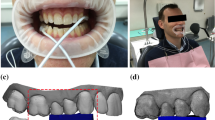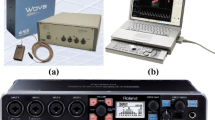Abstract
Electromagnetic articulography (EMA) is designed to track facial and tongue movements. In practice, the EMA sensors for tracking the movement of the tongue’s surface are placed heuristically. No recommendation exists. Within this paper, a model-based approach providing a mathematical analysis and a computational-based recommendation for the placement of sensors, which is based on the tongue’s envelope of movement, is proposed. For this purpose, an anatomically detailed Finite Element (FE) model of the tongue has been employed to determine the envelope of motion for retraction and elongation using a forward simulation. Two optimality criteria have been proposed to identify a set of optimal sensor locations based on the pre-computed envelope of motion. The first one is based on the assumption that locations exhibiting large displacements contain the most information regarding the tongue’s movement and are less susceptible to measurement errors. The second one selects sensors exhibiting each the largest displacements in the anterior-posterior, superior-inferior, medial-lateral and overall direction. The quality of the two optimality criteria is analysed based on their ability to deduce from the respective sensor locations the corresponding muscle activation parameters of the relevant muscle fibre groups during retraction and elongation by solving the corresponding inverse problem. For this purpose, a statistical analysis has been carried out, in which sensor locations for two different modes of deformation have been subjected to typical measurement errors. Then, for tongue retraction and elongation, the expectation value, the standard deviation, the averaged bias and the averaged coefficient of variation have been computed based on 41 different error-afflicted sensor locations. The results show that the first optimality criteria is superior to the second one and that the averaged bias and averaged coefficient of variation decrease when the number of sensors is increased from 2, 4 to 6 deployable sensors.
Similar content being viewed by others
References
Baer T, Alfonso P, Honda K (1988) Electromyography of the tongue muscles during vowels in /gpvp/ environment. Annu Bull Res Inst Logop Phoniatr 7: 7–18
Blemker S, Pinsky P, Delp S (2005) A 3D model of muscle reveals the causes of nonuniform strains in the biceps brachii. J Biomech 38(4): 657–665
Cheng C, Peng C, Chiou H, Tsai C (2002) Dentofacial morphology and tongue function during swallowing. Am J Orthod Dentofac Orthop 122(5): 491–499
Cheng S, Gandevia SC, Green M, Sinkus R, Bilston LE (2011) Viscoelastic properties of the tongue and soft palate using MR elastography. J Biomech 44(3): 450–454
De Groot J, Van Leeuwen J (2004) Evidence for an elastic projection mechanism in the chameleon tongue. Proc R Soc B Biol Sci 271(1540): 761–770
Fujiu M, Logemann J, Pauloski B (1995) Increased postoperative posterior pharyngeal wall movement in patients with anterior oral cancer: preliminary findings and possible implications for treatment. Am J Speech Lang Pathol 4(2): 24–30
Gerard J, Ohayon J, Luboz V, Perrier P, Payan Y (2005) Non-linear elastic properties of the lingual and facial tissues assessed by indentation technique: application to the biomechanics of speech production. Med Eng Phys 27(10): 884–892
Gilbert R, Napadow V, Gaige T, Wedeen V (2007) Anatomical basis of lingual hydrostatic deformation. J Exp Biol 210(23): 4069–4082
Goozee J, Murdoch B, Theodoros D, Stokes P (2000) Kinematic analysis of tongue movements in dysarthria following traumatic brain injury using electromagnetic articulography. Brain Inj 14(2): 153–174
Hiiemae K, Palmer J (2003) Tongue movements in feeding and speech. Crit Rev Oral Biol Med 14(6): 413–429
Honda K, Kitamura T, Takemoto H, Adachi S, Mokhtari P, Takano S, Nota Y, Hirata H, Fujimoto I, Shimada Y, Masaki S, Fujita S, Dang J (2010) Visualisation of hypopharyngeal cavities and vocal-tract acoustic modelling. Comput Methods Biomech Biomed Eng 13(4): 443–453
Jiang J, Alwan A, Keating P, Auer E, Bernstein L (2002) On the relationship between face movements, tongue movements, and speech acoustics. EURASIP J Appl Signal Process 11: 1174–1188
Kanner D (1991) Sensor placement for on-orbit modal identification and correlation of large space structures. In: American control conference, 1990, IEEE, pp 2984–2990
Karlsson D, Tranberg R (1999) On skin movement artefact-resonant frequencies of skin markers attached to the leg. Hum Mov Sci 18(5): 627–635
Katz W, Bharadwaj S, Carstens B (1999) Electromagnetic articulography treatment for an adult with Broca’s aphasia and apraxia of speech. J Speech Lang Hear Res 42(6): 1355–1366
Kieser J, Bolter C, Raniga N, Waddell J, Swain M, Farland G (2011) Tongue-palate interaction during swallowing. J Texture Stud 42(2): 95–102
Moeslund T, Granum E (2001) A survey of computer vision-based human motion capture. Comput Vis Image Underst 81(3): 231–268
Moeslund T, Hilton A, Kruger V (2006) A survey of advances in vision-based human motion capture and analysis. Comput Vis Image Underst 104(2-3): 90–126
Moré J, Sorensen D (1983) Computing a trust region step. SIAM J Sci Stat Comput 4(3): 553–572
Napadow V, Chen Q, Wedeen V, Gilbert R (1999a) Intramural mechanics of the human tongue in association with physiological deformations. J Biomech 32(1): 1–12
Napadow V, Chen Q, Wedeen V, Gilbert R (1999) Biomechanical basis for lingual muscular deformation during swallowing. Am J Physiol Gastrointest Liver Physiol 277(3): 695–701
Napadow V, Kamm R, Gilbert R (2002) A biomechanical model of sagittal tongue bending. J Biomech Eng 124(5): 547–556
Nash M, Hunter P (2000) Computational mechanics of the heart. J Elast 61(1): 113–141
Nozaki S, Umaki Y, Sugishita S, Tatara K, Adachi K, Shinno S (2007) Videofluorographic assessment of swallowing function in patients with duchenne muscular dystrophy. Clin Neurol 47(7): 407–412
Oliven A, Odeh M, Geitini L, Oliven R, Steinfeld U, Schwartz A, Tov N (2007) Effect of coactivation of tongue protrusor and retractor muscles on pharyngeal lumen and airflow in sleep apnea patients. J Appl Physiol 103(5): 1662–1668
Papadimitriou C, Beck J, Au S (2000) Entropy-based optimal sensor location for structural model updating. J Vib Control 6(5): 781– 800
Peng C, Jost-Brinkmann P, Miethke R, Lin C (2000) Ultrasonographic measurement of tongue movement during swallowing. J Ultrasound Med 19(1): 15
Proffit W, Fields H, Sarver D (2007) Contemporary orthodontics. Mosby Inc, Missouri
Röhrle O (2010) Simulating the electro-mechanical behavior of skeletal muscles. Comput Sci Eng 12(6): 48–58
Röhrle O, Pullan A (2007) Three-dimensional finite element modelling of muscle forces during mastication. J Biomech 40(15): 3363– 3372
Röhrle O, Waddell J, Foster K, Saini H, Pullan A (2009) Using a motion-capture system to record dynamic articulation for application in cad/cam software. J Prosthodont 18(8): 703–710
Saini H, Wadell J, Pullan A, Röhrle O (2009) Automatically generating subject-specific functional tooth surfaces using virtual mastication. Ann Biomed Eng 37(8): 1646–1653
Saitoh E, Shibata S, Matsuo K, Baba M, Fujii W, Palmer J (2007) Chewing and food consistency: effects on bolus transport and swallow initiation. Dysphagia 22(2): 100–107
Sauerland E, Harper R (1976) The human tongue during sleep: electromyographic activity of the genioglossus muscle. Exp Neurol 51(1): 160–170
Schmitt S, Günther M (2011) Human leg impact: energy dissipation of wobbling masses. Arch Appl Mech 81(7): 887–897
Spencer A (2004) Continuum mechanics. Dover, New York
Spitzer V, Ackerman M, Scherzinger A, Whitlock D (1996) The visible human male: a technical report. J Am Med Inform Assoc 3(2): 118C130
Steele C, van Lieshout P (2004) Use of electromagnetic midsagittal articulography in the study of swallowing. J Speech Lang Hear Res 47(2): 342–352
Steele C, Van Lieshout P (2009) Tongue movements during water swallowing in healthy young and older adults. J Speech Lang Hear Res 52(5): 1255–1267
Stone M, Davis EP, Douglas AS, NessAiver M, Gullapalli R, Levine WS, Lundberg A (2001) Modeling the motion of the internal tongue from tagged cine-MRI images. J Acoust Soc Am 109(6): 2974–2982
Stone M, Epstein M, Iskarous K (2004) Functional segments in tongue movement. Clin Linguist Phon 18(6-8): 507–521
Titze I (1994) Mechanical stress in phonation. J Voice 8(2): 99–105
Ucinski D (2000) Optimal sensor location for parameter estimation of distributed processes. Int J Control 73(13): 1235–1248
Wang Y (2008) Modelling mechanical properties of interlacing muscle fibres within the tongue. Master’s thesis, The University of Auckland, New Zealand
Yuan Y (2000) A review of trust region algorithms for optimization. In: Proceedings of the 4th international congress on industrial and applied mathematics, ICM99, pp 271–282
Yunusova Y, Green J, Mefferd A (2009) Accuracy assessment for AG500, electromagnetic articulograph. J Speech Lang Hear Res 52(2): 547–555
Zhong X, Epstein F, Spottiswoode B, Helm P, Blemker S (2008) Imaging two-dimensional displacements and strains in skeletal muscle during joint motion by cine dense mr. J Biomech 41(3): 532–540
Author information
Authors and Affiliations
Corresponding author
Rights and permissions
About this article
Cite this article
Wang, Y.K., Nash, M.P., Pullan, A.J. et al. Model-based identification of motion sensor placement for tracking retraction and elongation of the tongue. Biomech Model Mechanobiol 12, 383–399 (2013). https://doi.org/10.1007/s10237-012-0407-6
Received:
Accepted:
Published:
Issue Date:
DOI: https://doi.org/10.1007/s10237-012-0407-6




